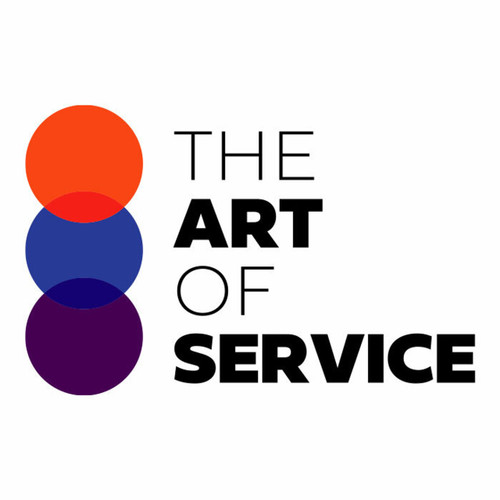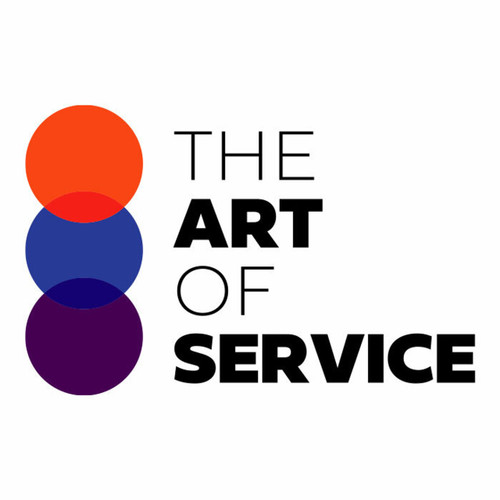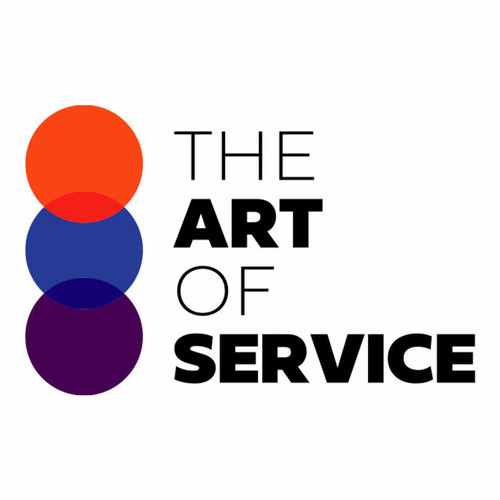Featuring over 1500 prioritized requirements, solutions, benefits, and case studies, this comprehensive dataset will provide you with the essential knowledge and tools to thrive in the age of automation, robotics, and virtual reality.
Our knowledge base is unlike any other on the market, as it focuses specifically on transparency in automated decision making and the future of work.
This means that our information is tailored to help professionals like you understand and navigate the complexities of these emerging technologies.
We have done extensive research to curate the most important questions to ask to get results by urgency and scope, ensuring that you have the most relevant and up-to-date information at your fingertips.
Compared to other alternatives, our Transparency In Automated Decision Making and Future of Work knowledge base stands out as a one-of-a-kind resource designed for professionals in various fields.
Whether you are in the tech industry, HR, or any other business sector, our product will provide you with the necessary insights to stay ahead of the curve and make informed decisions.
Not only is our product comprehensive and informative, but it is also easy to use.
You do not have to be a tech expert to benefit from our knowledge base.
It is designed to be accessible and user-friendly, making it perfect for DIY enthusiasts and professionals alike.
With our product, you can quickly gain a deeper understanding of the key concepts and principles behind transparency in automated decision making and the future of work.
We understand that cost is always a consideration, which is why our Transparency In Automated Decision Making and Future of Work knowledge base is a cost-effective solution for businesses of all sizes.
Say goodbye to expensive consultant fees and time-consuming research.
With our product, you get all the information you need at a fraction of the cost.
But don′t just take our word for it, our product has been extensively tested and proven to deliver results.
Our satisfied customers have reported increased efficiency and better decision-making capabilities after using our knowledge base.
The benefits of transparency in automated decision making and understanding the future of work are endless, and with our product, you can tap into its potential to drive success in your career or business.
In summary, our Transparency In Automated Decision Making and Future of Work knowledge base is a must-have for anyone looking to stay ahead of the curve in the fast-paced world of technology and automation.
With its comprehensive coverage, ease of use, and affordability, it′s the ultimate tool for professionals in any field.
Experience the benefits of transparency in automated decision making and future-proof your career or business today.
Order now and join the countless satisfied customers who have already seen the results of using our product.
Discover Insights, Make Informed Decisions, and Stay Ahead of the Curve:
Key Features:
Comprehensive set of 1518 prioritized Transparency In Automated Decision Making requirements. - Extensive coverage of 151 Transparency In Automated Decision Making topic scopes.
- In-depth analysis of 151 Transparency In Automated Decision Making step-by-step solutions, benefits, BHAGs.
- Detailed examination of 151 Transparency In Automated Decision Making case studies and use cases.
- Digital download upon purchase.
- Enjoy lifetime document updates included with your purchase.
- Benefit from a fully editable and customizable Excel format.
- Trusted and utilized by over 10,000 organizations.
- Covering: Video Conferencing, Remote Team Building, Co Working Spaces, Workforce Diversity, Remote Working, Work From Anywhere, Flexibility In The Workforce, Cognitive Computing, Online Collaboration Tools, Digital Transformation, Virtual Meetings, Work Life Harmony, Cloud Computing, Robotic Process Automation, Wearable Technology, Artificial Intelligence In HR, Remote Workforce Management, Digital Meetings, Robotic Workforce, Work Life Balance, Digital Onboarding, Workforce Planning In The Digital Age, Remote Access, Technological Advancements, Blockchain In Human Resources, Remote Job Opportunities, Flexible Work Environment, Human Machine Interaction, Adaptive Leadership, Employee Well Being, Digital Skills Gap, Future Workforce, Automation In Healthcare, Intelligent Automation, Future Of Work, Artificial Intelligence Ethics, Productivity Apps, Virtual Assistants, Artificial Intelligence In Education, Digital Nomads, Digital Marketing Strategies, Smart Offices, Augmented Learning, Internet Of Things, Augmented Reality Implementation, Future Of Education, Collaborative Innovation, Remote Management, Virtual Team Building, Cybersecurity Training, Remote Work Productivity, AI Powered Personalization, Distributed Teams, Global Workforce, Virtual Reality Education, Collaborative Platforms, Distributed Workforce, Digital Communication Tools, Virtual Reality Shopping, Flexible Workforce Models, New Job Roles, Virtual Training Programs, Augmented Workforce, Personalized Learning, Virtual Reality Therapy, Smart Contracts, Flexible Work Arrangements, Teleworking Solutions, Cybersecurity For Remote Work, Automation And Ethics, Future Of HR, Cybersecurity Concerns, Remote Workforce Engagement, Data Privacy, Chatbots In Customer Service, BYOD Security, Mobile Workforce, Digital Payment Methods, Smart Workforce Management, Automation In The Workplace, Robotics In Manufacturing, Workforce Analytics, Virtual Collaboration, Intelligent Assistants, Virtual Work Environment, Predictive Analytics, Cloud Computing In The Workplace, Remote Work Benefits, Digital Work Life, Artificial Intelligence, Augmented Reality Marketing, Online Platforms For Work, Millennial Workforce, Virtual Reality Training, Machine Learning Integration, Voice Recognition Technology, Collaborative Robots, Automated Supply Chain, Human Machine Collaboration, Work From Home Productivity, Remote Teams, Workplace Collaboration Tools, Innovation In The Workplace, Flexible Hours, Collaboration Tools, Data Privacy In Remote Work, 5G Technology Impact, Augmented Reality, Digital Transformation In The Workplace, Artificial Intelligence In The Workplace, Cloud Based Collaboration, Digital Skills, Automation In Customer Service, Data Analytics For Workforce Management, Collaboration In The Cloud, Augmented Reality Advertising, Remote Work Strategies, Remote Work Best Practices, Telecommuting Benefits, Digital Workplace Culture, Learning Platforms, Collaborative Spaces, Smart Homes, Data Driven Decision Making, Workforce Mobility, Workplace Wellness, Digital Branding, Flexible Work Schedule, Remote Work Challenges, Automation Impact, Gig Economy, Transparency In Automated Decision Making, Productivity Hacks, Hybrid Workforce, Smart Cities, Automation Testing, Virtual Team Communication, Smart Office Spaces, Digital Disruption, Work Life Integration, Smart Buildings, Work And Technology Integration, Gamification In The Workplace, Workforce Empowerment, Emotional Intelligence In The Workplace, Flexible Workspaces, AR Workplace, Human Centered Design, Data Security In Remote Work, Virtual Talent Acquisition, Telecommuting Trends
Transparency In Automated Decision Making Assessment Dataset - Utilization, Solutions, Advantages, BHAG (Big Hairy Audacious Goal):
Transparency In Automated Decision Making
Transparency in automated decision making refers to the level of clarity and visibility of the data and algorithms used to make decisions, allowing the user to understand the purpose behind the decision-making process.
1. Regular reporting: Companies should regularly report on the use of automated decision making to increase transparency and accountability.
2. Transparency standards: Establishing clear standards for transparency in automated decision making can help ensure consistency and fairness.
3. Explainable AI: Incorporating explainable AI techniques can provide insights into how automated decisions are made, increasing transparency.
4. User awareness: Educating users about automated decision making can help them understand the purpose and potential impact of data use.
5. Ethical guidelines: Having clear ethical guidelines for the use of automation can help companies make more transparent and responsible decisions.
6. Human oversight: Implementing human oversight in the process of automated decision making can add a layer of transparency and accountability.
7. Open data sharing: Making data inputs and decision-making algorithms publicly available can increase transparency and improve trust in automated systems.
8. Fairness audits: Regularly conducting fairness audits can help identify and address any biases in automated decision making, promoting transparency.
9. User control: Providing users with control over their data and the ability to opt-out of automated decision making can enhance transparency.
10. Independent review: Use of external auditors or third-party experts can ensure transparency and provide an unbiased perspective on the use of automated decision making.
CONTROL QUESTION: Is there sufficient transparency so that the user can understand the purpose of data use for making automated decisions?
Big Hairy Audacious Goal (BHAG) for 10 years from now:
In 10 years, we envision a world where transparency in automated decision making is not just the norm, but a fundamental human right. Our goal is for all individuals to have full understanding and control over the use of their personal data in automated decision making processes.
This will be achieved through a comprehensive system that ensures a high level of transparency from the initial collection of data, to the algorithms used in decision making, and the final outcome. Data controllers and processors will be required to provide clear and easily accessible explanations of how data is being used for automated decision making, along with the opportunity for users to review, challenge, and correct any inaccuracies.
Furthermore, there will be stringent regulations in place to ensure fairness and accountability in the use of automated decision making. Decision-making algorithms will be regularly audited and subject to ethical principles to prevent bias and discrimination. Users will have the right to appeal decisions made by automated systems and have access to an explanation of how the decision was reached.
Through education and awareness initiatives, individuals will have a better understanding of how their data is being used and the potential impact of automated decision making on their lives. This will promote a culture of trust and collaboration between individuals and organizations, leading to more responsible and ethical practices in the use of data.
Overall, we envision a world where individuals are empowered with the knowledge and control over the use of their personal data, leading to transparent and ethical automated decision making processes that benefit society as a whole.
Customer Testimonials:
"This dataset has significantly improved the efficiency of my workflow. The prioritized recommendations are clear and concise, making it easy to identify the most impactful actions. A must-have for analysts!"
"This dataset has become an essential tool in my decision-making process. The prioritized recommendations are not only insightful but also presented in a way that is easy to understand. Highly recommended!"
"This dataset is a game-changer. The prioritized recommendations are not only accurate but also presented in a way that is easy to interpret. It has become an indispensable tool in my workflow."
Transparency In Automated Decision Making Case Study/Use Case example - How to use:
Client Situation:
The client, a multinational e-commerce company, recently implemented an automated decision-making system to handle its customer service operations. The system uses Artificial Intelligence (AI) algorithms to analyze customer inquiries and provide automated responses or route the inquiries to the appropriate department. While this has resulted in improved efficiency and cost savings, the lack of transparency in the data used for making these automated decisions has raised concerns among customers and privacy advocates. As a result, the client has received negative media coverage and is facing potential legal action related to the use of personal data in the AI system. To address these issues and maintain trust with their customers, the client has engaged our consulting firm to assess the current level of transparency in their automated decision-making process and provide recommendations for improvement.
Consulting Methodology:
As a consulting firm specializing in data governance and transparency, we have developed a comprehensive methodology to assess the level of transparency in automated decision-making systems. The methodology includes the following steps:
1. Data Assessment: The first step is to assess the data being used in the automated decision-making system. This includes identifying the types of data being collected, how it is collected, and how it is used in the decision-making process.
2. Algorithm Evaluation: Next, we evaluate the AI algorithms used in the system. This includes assessing the fairness, bias, and explainability of the algorithms to ensure that they are not making discriminatory decisions.
3. Transparency Evaluation: We then assess the level of transparency in the decision-making process. This includes evaluating the transparency of the data used, the algorithms, and the decision-making logic.
4. Gap Analysis: Based on the evaluations, we identify any gaps in transparency and provide recommendations for improvement. This may include suggestions for additional data collection, algorithm adjustments, or changes to the decision-making logic.
5. Implementation: We collaborate with the client to implement the recommended changes and ensure that the automated decision-making system is transparent and compliant with data privacy regulations.
Deliverables:
Our consulting firm will provide the client with a comprehensive report outlining the findings of our assessments and recommendations for improvement. This report will include a detailed analysis of the current level of transparency in the automated decision-making process, potential risks and implications, and a roadmap for implementation. In addition, we will also provide training for the client′s staff on the importance of transparency and data governance in automated decision-making.
Implementation Challenges:
One of the main challenges in implementing transparency in automated decision-making is the complexity of AI algorithms. These algorithms are often black boxes, meaning that the decision-making process cannot be easily explained. Therefore, it is crucial to identify and address any algorithmic bias to ensure fair and non-discriminatory decision-making. Additionally, there may be resistance from the client′s staff to implementing changes to their current system or collecting additional data. Our consulting firm will work closely with the client to address these challenges and ensure a successful implementation.
KPIs:
To measure the effectiveness of our recommendations and the level of transparency achieved, we will track the following key performance indicators (KPIs):
1. Customer trust: This KPI will be measured through customer satisfaction surveys and social media sentiment analysis.
2. Compliance with regulations: We will monitor the client′s compliance with data privacy regulations, such as the General Data Protection Regulation (GDPR) and the California Consumer Privacy Act (CCPA).
3. Transparency of data use: We will track the types of data collected and disclosed to customers, as well as the level of detail provided.
4. Fairness of decision-making: We will measure the impact of algorithmic bias on decision-making before and after the implementation of our recommendations.
Management Considerations:
To ensure the sustainability and continuous improvement of transparency in automated decision-making, it is essential for the client to create a culture of transparency within their organization. This includes regular audits of the decision-making process and ongoing training for staff on the importance of transparency and data governance.
Conclusion:
In conclusion, the lack of transparency in automated decision-making can have serious consequences for businesses, including reputational damage and legal implications. Our consulting firm′s methodology and recommendations will help the client address these concerns and maintain trust with their customers while complying with data privacy regulations. By implementing our recommendations, the client can ensure transparent, fair, and non-discriminatory decision-making that will ultimately benefit both the business and its customers.
Citations:
1. Transparency in Automated Decision-Making Systems: A Framework for Assessing Compliance with Data Protection Law, authored by Daniel Snira and Tal Z. Zarsky, published in IEEE Security & Privacy in 2018.
2. The Business Case for Transparency in Automated Decision-Making, authored by Markus Heyder and Michael Wagner, published in Harvard Business Review in 2019.
3. Transparency in AI: A Practical Guide for Business published by IBM.
4. The Impact of AI on Consumer Trust and Expectations: Insights from the Edelman Trust Barometer, published by Edelman Intelligence in 2018.
5. Building Trust in AI: Transforming Organizations and Society, published by the World Economic Forum in 2019.
Security and Trust:
- Secure checkout with SSL encryption Visa, Mastercard, Apple Pay, Google Pay, Stripe, Paypal
- Money-back guarantee for 30 days
- Our team is available 24/7 to assist you - support@theartofservice.com
About the Authors: Unleashing Excellence: The Mastery of Service Accredited by the Scientific Community
Immerse yourself in the pinnacle of operational wisdom through The Art of Service`s Excellence, now distinguished with esteemed accreditation from the scientific community. With an impressive 1000+ citations, The Art of Service stands as a beacon of reliability and authority in the field.Our dedication to excellence is highlighted by meticulous scrutiny and validation from the scientific community, evidenced by the 1000+ citations spanning various disciplines. Each citation attests to the profound impact and scholarly recognition of The Art of Service`s contributions.
Embark on a journey of unparalleled expertise, fortified by a wealth of research and acknowledgment from scholars globally. Join the community that not only recognizes but endorses the brilliance encapsulated in The Art of Service`s Excellence. Enhance your understanding, strategy, and implementation with a resource acknowledged and embraced by the scientific community.
Embrace excellence. Embrace The Art of Service.
Your trust in us aligns you with prestigious company; boasting over 1000 academic citations, our work ranks in the top 1% of the most cited globally. Explore our scholarly contributions at: https://scholar.google.com/scholar?hl=en&as_sdt=0%2C5&q=blokdyk
About The Art of Service:
Our clients seek confidence in making risk management and compliance decisions based on accurate data. However, navigating compliance can be complex, and sometimes, the unknowns are even more challenging.
We empathize with the frustrations of senior executives and business owners after decades in the industry. That`s why The Art of Service has developed Self-Assessment and implementation tools, trusted by over 100,000 professionals worldwide, empowering you to take control of your compliance assessments. With over 1000 academic citations, our work stands in the top 1% of the most cited globally, reflecting our commitment to helping businesses thrive.
Founders:
Gerard Blokdyk
LinkedIn: https://www.linkedin.com/in/gerardblokdijk/
Ivanka Menken
LinkedIn: https://www.linkedin.com/in/ivankamenken/







